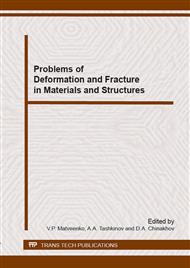[1]
Vladimirov V.I., The Physical Nature of the Fracture of Metals, Metallurgy, Moscow, (1984).
Google Scholar
[2]
Fedorov V.V., Thermodynamic Aspects of Strength and Fracture of Solids, FAN, Tashkent, (1979).
Google Scholar
[3]
Taylor G.I., Quinney H., The latent heat remaining in a metal after cold working, Proc. R. Soc. A. 143 (1934) 307-326.
Google Scholar
[4]
Bever M.B., Holt D.L., Titchener A.L., The Stored Energy of Cold Work, Pergamon, New York, (1973).
Google Scholar
[5]
Oliferuk W., Korbel A., Bochniak W., Energy balance and macroscopic strain localization during plastic deformation of polycrystalline metals, Mat. Sci. Eng. A. 319-321 (2001) 250-253.
DOI: 10.1016/s0921-5093(01)01061-9
Google Scholar
[6]
Fedorova A. Yu., Bannikov M.V., Plekhov O.A., A study of the stored energy in titanium under deformation and failure using infrared data, Fracture and Structural Integrity. 24 (2013) 81-88.
DOI: 10.3221/igf-esis.24.08
Google Scholar
[7]
Aravas N., Kim K-S., Leckie F.A., On the calculation of the stored energy of cold work, J. Eng. Mater-T. 112 (1990) 465-470.
Google Scholar
[8]
Szczepinski W., The stored energy in metals and the concept of residual microstresses in plasticity, Arch. Mech. 53 (2001) 615-629.
Google Scholar
[9]
Oliferuk W., Maj M., Stress-strain curve and stored energy during uniaxial deformation of polycrystals, Eur. J. Mech. A-Solids. 28 (2009) 266-272.
DOI: 10.1016/j.euromechsol.2008.06.003
Google Scholar
[10]
Benzerga A. A., et al., The stored energy of cold work: predictions from discrete dislocation plasticity, Acta Mater. 53 (2005) 4765-4779.
DOI: 10.1016/j.actamat.2005.07.011
Google Scholar
[11]
Rosakis P., et al., A thermodynamic internal variable model for the partition of plastic work into heat and stored energy in metals, J. Mech. Phys. Solids. 48 (2000) 581-607.
DOI: 10.1016/s0022-5096(99)00048-4
Google Scholar
[12]
Chaboche J-L., Cyclic viscoplastic constitutive equations, J. Appl. Mech. 60 (1993) 813-828.
Google Scholar
[13]
Naimark O.B., Collective properties of defects ensemble and some nonlinear problems of plasticity and failure, Phys. Mesomech. 50 (2009) 127-136.
Google Scholar
[14]
Plekhov O.A., Eremeev D.N., Naimark O.B., Failure wave as a resonance excitation of collective burst modes of defects in shocked brittle materials, J. Phys. IV. 10 (2000) 811-816.
DOI: 10.1051/jp4:20009134
Google Scholar
[15]
Plekhov O.A., Naimark O.B., Theoretical and experimental study of energy dissipation in the course of strain localization in iron, J. Appl. Mech. Tech. Phys. 50 (2009) 127-136.
DOI: 10.1007/s10808-009-0018-x
Google Scholar
[16]
Glansdorff P., Prigogine I., Thermodynamic Theory of Structure, Stability and Fluctuations, Wiley, New York, (1971).
Google Scholar
[17]
Oliferuk W., Maj M., Energy storage rate in non-homogeneous deformation, Proceedings of the 21st International congress of theoretical and applied mechanics (ICTAM04). E-book, (2005) 1185.
Google Scholar


